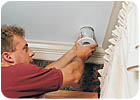
When the dog days of summer hit, it's nice to put the air-conditioning on, cool the house and lower the humidity. But many owners of older homes without forced-air heating systems either don't have a convenient space to install ductwork for a traditional central air system, or they're put off by the cost and difficulty of the installation process itself. For these homeowners, a high-velocity, or mini-ductless, system may be what they're looking for.
So what is a high-velocity air-conditioning system? They use small diameter, flexible, pre-insulated ducts - mini-ducts - that can be easily threaded through existing floors, ceilings and walls to deliver cool air where needed, making them ideal for retrofit installations. They are also ideal for homes with hydronic or radiant floor heating systems.
The “registers” are actually small discs placed around the perimeter of the ceiling, high on the walls or on the floor. Most can be painted or wall-papered to fit the décor of any room.
According to the Partnership for Advancing Technology in Housing (PATH), a special fan coil and air handling unit generates high-pressure air, which is forced through ducts; a main supply trunk supplies air to the flexible, 2-inch plastic feeder ducts. The air passes through sound-suppressing tubing at the end of the duct before entering the room through a plastic collar fitting, or register. Air is supplied at 440 to 1,200 cubic ft. per minute.
Manufacturers claim these systems are quiet, improve dehumidification, room air mixing, and energy efficiency over standard systems. High-velocity system air handlers can satisfy cooling capabilities between 18,000 Btuh and 60,000 Btuh, and removes nearly 30 percent more moisture in the cooling mode than traditional systems.
Lower humidity levels allows for comfort with the thermostat set at a higher temperature, which means lower energy bills. Less humidity also means a reduction in mold and mildew, which can trigger an allergic reaction in some people.
Who installs these systems? In an exclusive study conducted in April, Plumbing & Mechanical asked 1,500 of its subscribers to evaluate their installation practices of high-velocity air-conditioning systems, as well as the market in general. We received a 12 percent response rate, and 41 percent of respondents said they installed such systems last year.
Most of these systems are retrofit installations - 60 percent. These would be installations in those older homes previously mentioned. Thirty percent were installed in new residential single-family construction, while 4 percent were installed in new multiresidential construction. About 6 percent were installed in commercial/industrial buildings.
While 43 percent of respondents expect an increase in high-velocity installs this year, almost two-thirds (64 percent) see an increase in installation of these systems over the next five years.
PATH notes that the initial cost of high-velocity systems is more than traditional central air systems, but the payback is reduced energy bills for the customer. The systems are also easy to install as the flexible tubing is designed to fit an existing structure without major remodeling - more cost savings for the customer - but some heating and cooling contractors may be unfamiliar with the these types of ducts.
Recently, contractors on The Wall (www.heatinghelp.com) debated this very subject - some had high praise for HV systems, while others had nothing but complaints. But all pretty much agree that the proper design and installation can make a lot of difference in the performance of these systems - this includes proper sizing of the system for each home.
A complete copy of PM's “Installation: High Velocity Air-Conditioning Study” - including more information on product and brand decisions - can be purchased for $95. To order, contact Cory Maxwell at 248/244-6415, maxwellc@bnpmedia.com.
What was your company's total dollar volume of HV air-conditioning installations in 2005?
$10,000 or less - 30%$10,001 - $30,000 - 28%
$30,001 - $50,000 - 26%
More than $50,000 - 16%
